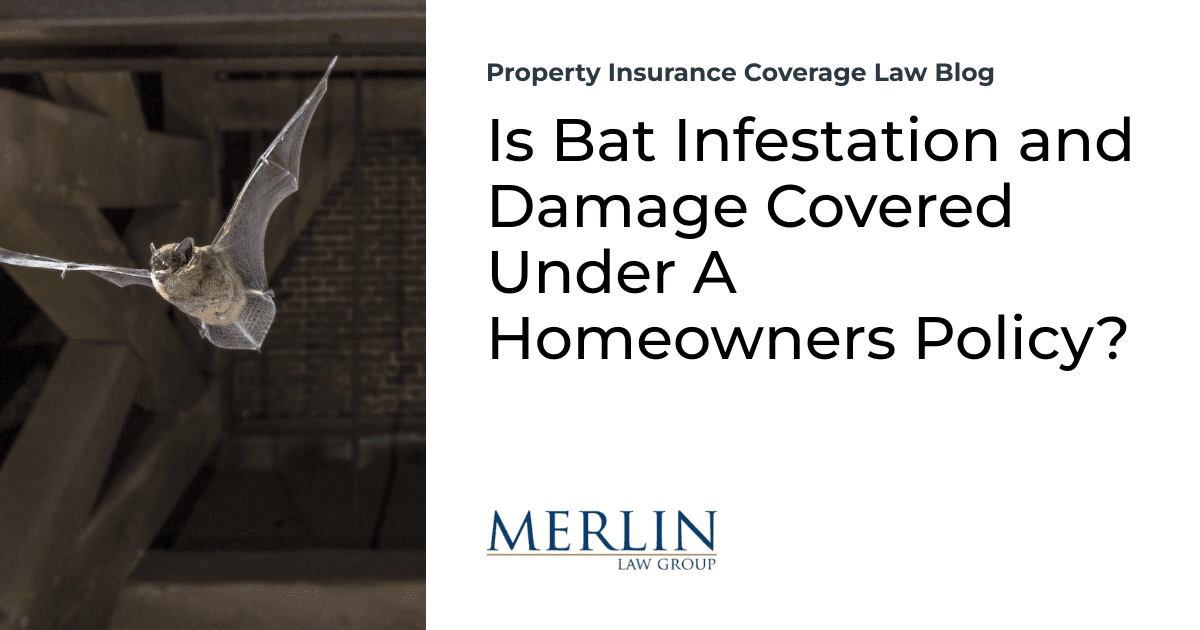Is Bat Infestation and Damage Covered Under A Homeowners Policy?

A recently reported case drove me a little “batty” (pun intended) because it did not reach a conclusion or cite policy provisions when considering whether a case involving bat infestation would be covered under a homeowners policy.1 The appellate court sent the matter back to the trial court for further consideration and development of facts.
The preliminary facts of that case, which is now still ongoing, are as follows:
According to State Farm, Respondents made a claim regarding a bat infestation in 2017. However, State Farm contends that bats had been an ongoing problem at the Property for years prior to 2017. According to State Farm, Dr. Shackelford’s wife, Mrs. Shackelford, testified that, prior to 2015, she had been cleaning up from what she thought was damage caused by mice but later learned was damage from bats.
According to Dr. and Mrs. Shackelford, they contracted with Terminix in 2015 to remove a bat infestation, which they allege constituted the first time that they were made aware of the bat problem. Dr. and Mrs. Shackelford contend that they discovered a ‘separate and distinct’ bat infestation in July of 2017 and submitted a claim for that infestation on July 11, 2017. State Farm responded that the bats presented a safety concern for an inspection and informed Dr. Shackelford that the bats needed to be removed before a State Farm employee could inspect the Property. According to State Farm, on December 28, 2017, it was advised that the roof of the house had been removed/replaced and that the Property was available for inspection. An inspection of the dwelling was conducted on February 6, 2018. By letter dated February 27, 2018, State Farm denied the claim. In support of its denial, State Farm identified several issues including, but not limited to, Dr. Shackelford’s failure to promptly notify State Farm of the claim and to permit State Farm to view and/or document the removal of the roof or damage to the property, and lack of coverage under the Policy due to various exclusions.
My guess is that Jake from State Farm will not be showing advertisements with strange losses caused by bats.
So, is there coverage for bat infestation and damages caused by bats to the home?
There is one decision saying that bat poop is not covered under a homeowners policy because of a “pollution exclusion.” The Wisconsin Supreme Court ruled:
We conclude that the pollution exclusion clause in Auto-Owners’ insurance policy excludes coverage for the loss of the Hirschhorns’ home that allegedly resulted from the accumulation of bat guano. First, we conclude that bat guano falls unambiguously within the policy’s definition of ‘pollutants.’ Second, we conclude that the Hirschhorns’ alleged loss resulted from the ‘discharge, release, escape, seepage, migration or dispersal’ of bat guano under the plain terms of the policy’s pollution exclusion clause.
Most pollution exclusions were written to avoid payment of industrial pollutants. The Wisconsin court is one that takes an expansive reading of this clause.
United Policyholders published a paper, Here’s The scoop: Bat Poop Leads to Legal Fight Over Home Insurance Claim, criticizing the Wisconsin decision. It stated in part:
Adam Scales, a professor at the Rutgers School of Law-Camden, says courts – like the Wisconsin Supreme Court in the bat guano case – also are interpreting exclusions more often in favor of insurance companies. That’s what happened in the Hirschhorn case, when the court ultimately decided that bat guano counted as pollution under the pollution exclusion.
‘This particular case involves something that almost no one would intuitively think of as pollution,’ Scales says. ‘Ask someone on the street what is pollution, and they might say something coming out of a smokestack or emissions coming out of a car or some green goo out back of an industrial plant – but they probably wouldn’t think about bat excrement.’
Arguing before the Wisconsin Supreme Court on behalf of Auto-Owners, attorney Timothy Barber pointed out that the same court in previous cases had found three other substances to count as pollution: dust from lead paint, the smell of fuel oil that had penetrated a house and the odor of a fabric softener that had contaminated some ice cream cones.
‘Over the past 20 to 30 years, courts have really stepped away from their mission of protecting the consumer from unfair or deceptive language in insurance policies and have embraced a much more insurer-friendly view of ‘plain meaning,’ Scales says. That refers to focusing on the narrow, literal meaning of a word in a policy rather than context and how a consumer might interpret the policy.
I found an insurance agency with an excellent discussion of the topic, Are Bats in the Attic Covered Under the Homeowners’ Policy? They noted that the AAIS forms have an expanded exclusion of vermin, which includes bats. They advise reading the policy to see if there is a specific exclusion.
The agency article also indicates that the policies covering and not excluding bat damage will still not provide coverage to remove the bats. Under that view, the infestation of bats is not physical damage to property.
I will certainly keep you apprised of the status of the bat case. But, until then, I promise you that if Batman runs his Batmobile into a home, coverage will be afforded.
Thought For The Day
In the late ’60s, there were the three B’s: The Beatles, Batman, and Bond.
—Adam West
_____________________________________________
1 Collectivo Coffee Roasters, Inc. v. Society Ins., No. 2021AP463, 2022 WI 36 (Wis. June 1, 2022).







